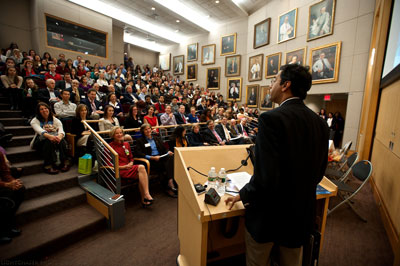"The Century of the System"

Atul Gawande delivers his keynote address to a packed Bornstein Amphitheater, as well as those watching from four overflow rooms. |
The average American can expect to undergo seven operations in his or her lifetime, plus four percutaneous procedures, such as catheterization or endoscopy.
“The refinement of our surgical abilities has allowed us to manipulate the human body in ways beyond what people even a few decades ago could imagine. More importantly, it has transformed people’s quality of life,” said Atul Gawande, MD, MPH, during his keynote speech at BWH Research Day. “But the evolution of surgery has also brought new concerns – how to ensure quality and appropriateness of procedures and manage costs.”
Gawande, a renowned surgeon at BWH, writer and researcher, summoned the Brigham community to address the most pressing challenges in health care today through innovation and teamwork.
Calling this new period in health care “the century of the system,” Gawande spoke about the systematic ways health care leaders must improve efficiency and collaboration for better quality of care at a lower cost. “We need discoveries that not only we can use, but that can be used across the country,” he said. “That involves research and collaboration at every level.”
He referenced a recent study that discovered there are four types of breast cancer instead of two, as previously thought. The study listed more than 300 authors. “It’s a new world where a professor is OK with being listed as author 248 because of what the impact of that research will be,” Gawande said. “That type of collaboration is part of our future at BWH.”
Gawande provided context for the challenges in health care today by leading his audience on a journey of the history of innovation in surgery.

Atul Gawande, MD, MPH |
In the early 1800s, surgery was a limited profession. “Pain restricted a surgeon’s reach,” Gawande said. That began to evolve with the discovery of anesthesia in the 1840s. Within the next decade, a series of new surgical procedures and anesthetics were developed, and narcotics were found to relieve post-operative suffering.
“Suddenly, pain was no longer a barrier to surgery, and new possibilities existed,” Gawande said. Advances in surgery flourished, and the practice was refined. “It was no longer just ‘the first’ that mattered, but how you bring the first to many,” he said.
Bringing engineering into the picture in more recent years has revolutionized the field once again, with the development of minimally invasive surgical procedures, reducing debilitating incisions into “mere puncture wounds,” Gawande said.
The innovations of the past have accelerated the field of surgery, and today, scientists and care providers must develop equally innovative solutions to address the new challenges in health care. Gawande concluded his presentation with inspiring words to the BWHers, patients, visitors, donors and others crowded into the Bornstein Amphitheater and four overflow conference rooms for the presentation:
“The Brigham is a place that has helped people achieve better lives throughout its history. I see no reason this can’t be continued, and many of you here will be the ones who do it.”